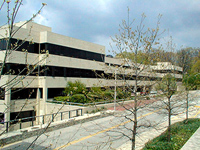Commissioning Hubble - preparing for science observations
9 June 2009
The fifth and final servicing mission for the Hubble Space Telescope may be over but for the ESA Hubble scientists at the Space Telescope Science Institute (STScI) in Baltimore, USA, the end of the servicing mission signalled the start of a period of intense investigation and analysis as the two new, and two repaired, instruments are commissioned and prepared for scientific observations.
 |
 |
|
Installing COS (top) and WFC3 (bottom) during SM4. Credit: NASA |
Preparations for science observations are now the top priority for the Hubble scientists tasked with delivering the refurbished telescope to the scientific community. Over the course of the next 15 weeks the ESA team at STScI will be involved in checking and calibrating the performance of each instrument against predicted responses. The purpose of these tests is to comprehensively document the behaviour of each instrument in order to provide users with a telescope whose characteristics are well-understood.
First tests performed during servicing mission
The 15-strong ESA Hubble team at STScI was already involved during the servicing mission when they, together with colleagues from NASA and the instrument teams, analysed telemetry from the spacecraft to assess the 'aliveness' of the instruments. The aliveness tests were carried out while the telescope was still in the shuttle cargo bay. These simple tests aimed to identify problems, such as incomplete connections, which could be remedied while the astronauts were still able to access Hubble.
 |
|
Hubble - back in orbit after SM4. Credit: NASA |
Once Hubble was released back into orbit on 19 May 2009 some functional tests were performed to check some of the basic modes of operation. Most of the testing must wait until outgassing has been completed and the telescope has reached an equilibrium state with its surroundings. At this stage the intensive commissioning activities will begin with every operational mode of each instrument being tested and calibrated following a pre-planned sequence of events. (See also "Hubble Revitalised - Science Mission Observatory Verification".)
End of commissioning marks hand-over to community
Once the instruments have been declared to have been successfully commissioned Hubble is turned over to the community of astronomers. The end of the commissioning period will be marked by the Early Release Observations – a series of astronomical images which will demonstrate the capabilities of the newly refurbished Hubble Space Telescope.
The first scientific observations for the new instruments will be mostly guaranteed time for the COS and WFC3 instrument teams. Observing time on the other instruments is assigned to astronomers who wrote winning proposals for the HST Call for Proposals for Cycle 17.
The ESA Hubble team at STScI
 |
|
The Space Telescope Science Institute. Credit: NASA |
The instrument complement on HST
The newly refurbished Hubble Space Telescope has a complement of six instruments:
COS (new): The Cosmic Origins Spectrograph will be the most sensitive ultraviolet spectrograph ever flown on Hubble. It is a slitless spectrograph designed to study the large-scale structure of the Universe by tracing hydrogen Lyman-alpha absorptions, the formation of galaxies, the chemical evolution of galaxies and the interstellar medium.
WFC3 (new): The Wide Field Camera 3 offers imaging capabilities from the UV through optical to the IR. It is particularly suitable for identifying galaxies in the very early Universe, and for studies of star formation and the chemical enrichment history of galaxies, type Ia supernovae and high-redshift galaxy formation.
ACS (repaired): The Advanced Camera for Surveys has produced some of the most iconic images from the Hubble Space Telescope in recent years. In 2007, five years after it was installed on Hubble, an electronic fault resulted in the loss of the Wide Field and High Resolution Channels. Repairs carried out by astronauts during SM4 restored the Wide Field Channel. Sky surveys with this channel have been used to study the nature and distribution of galaxies providing valuable data on the number of galaxies in the universe and determining the epoch of galaxy formation.
STIS (repaired): The Space Telescope Imaging Spectrograph combines a camera with a spectrograph, and covers a wide range of wavelengths from the near-infrared region into the ultraviolet. It ceased operations in August 2004, after 7.5 years of excellent performance, due to a power supply failure. Astronauts replaced a failed electronics board during SM4 thus restoring STIS to full use. STIS has been used to search for massive black holes, to map fine details of numerous celestial objects, and to obtain physical diagnostics, such as chemical composition, temperature, density and velocity of rotation in a wide variety of celestial objects.
NICMOS: The Near Infrared Camera and Multi-Object Spectrometer (NICMOS) provides IR imaging and limited spectroscopic observations of astronomical targets. No intervention was needed for NICMOS during SM4. While NICMOS will be largely superceded by the near infrared channel of WFC3 at wavelengths less than 1.7 microns, it will continue to provide unique observing capabilities between 1.7 and about 2.5 microns. NICMOS is well suited to the study of protostellar clouds, young star clusters and brown dwarfs, obscured active galaxy nuclei, temporal changes in planetary atmospheres, young protogalaxies, and protoplanetary disks.
FGS: Hubble has three Fine Guidance Sensors onboard. Two are used to point and lock the telescope on the target, and the third can be used for astrometric measurements – which provide stellar distances and orbital parameters for binary star systems. One FGS was replaced during SM4 thus extending the lifetime of Hubble’s pointing control system.
